So for years I've wanted a single action revolver in .45 Colt. Originally I was between the 1858 conversion and the Schofield. Looking more recently it looks like the Schofields have surpassed my price range. So now I am between the 1858 conversion by Uberti and the 1875 Outlaw by Cimarron, both with 5" +/- barrels. I have no experience with either and have never even seen either in person. So looking for some input. I don't really have a practical purpose for it other than I want it, maybe it'll tag along on a hog hunt once in a while.
You are using an out of date browser. It may not display this or other websites correctly.
You should upgrade or use an alternative browser.
You should upgrade or use an alternative browser.
Looking at single actions
- Thread starter Bigfatts
- Start date
Bishop Creek
New member
Well, I had a Schofield a few years ago and I liked it, but it gummed up quick with black powder cartridges which is my preference. Shot very well with smokeless though. The grip takes some getting used to. I also have an 1858 Remington with a Kirst conversion cylinder, shoots like a champ!
BC is correct, Schofields do not like black powder. I own a Uberti 1858 conversion in 44-40 and a Uberti 1875, also in 44-40 and there isn't a whole lot of difference between the two. They balance and feel about the same. Both shoot BP rounds well but still bind up quicker than a colt style revolver. The biggest difference is the ejector rods. On the 75' it is a spring loaded rod like the colts have. On the 58' you have to lower the loading lever, turn the rod head out and then you can unload the gun. The rod has no spring, so you have to punch out an empty shell, then pull the rod back out of the cylinder before you can turn to the next chamber. It sounds like more of an ordeal than it is, but the 75' is simpler. Both are great revolvers and I think you would be happy with either. Basically it boils down to which one looks better to you.
Thanks for the input guys. I am still looking at getting an 1858 but may start with a percussion and buy the conversion cylinder when I can afford it. Can anyone explain to me how the conversion actually works? It seems like a plate covers the cylinder and instead of pc nipples it has firing pins in their place. How do you reload it? Do you have to remove the cylinder?
And Hawg, I can't even tell you how happy I am with the TD. I've been hunting one for years. And to find one NIB for a very good price, too good to pass up.
And Hawg, I can't even tell you how happy I am with the TD. I've been hunting one for years. And to find one NIB for a very good price, too good to pass up.
I had an original TD carbine and I really liked it but somebody really wanted it bad so I let him have it... At a hefty profit I might add.
The conversion cylinders have a backing plate with five firing pins. You do have to remove it to load it. They do make gated conversions tho but require enlarging the loading port.
The conversion cylinders have a backing plate with five firing pins. You do have to remove it to load it. They do make gated conversions tho but require enlarging the loading port.
The conversion cylinders have a backing plate with five firing pins.
If you buy the from Taylor's, it is a six shot conversion cylinder.
The standard R&D cylinder that most places sell is a five shot. But Taylor's owns the rights to the six shot cylinders that Kenny Howell/R&D designed, so they are the only ones that can manufacture/sell them.
http://www.taylorsfirearms.com/cartridge-conversions/1858-remington-conversion-cylinders.html
http://www.taylorsfirearms.com/cartridge-conversions/1858-remington-conversion-cylinders.html
deerslayer303
New member
For the life of me I simply do not see the point in a conversion cylinder. You will have 500 bucks in a pistol that in reality was not designed to fire that ammo. Just buy a SAA clone and be done with it and spend the left over money on ammo. Just my .02
For the life of me I simply do not see the point in a conversion cylinder. You will have 500 bucks in a pistol that in reality was not designed to fire that ammo.
Then don't buy one. There is obviously a market for that sort of thing or else the manufacturers wouldn't manufacture them and the many, many retailers that sell them wouldn't sell them. The conversion cylinders have been around, and popular for well over a decade. If you want to get technical, the original conversions of the 1860s and 70s weren't designed to fire cartridges either. But they worked quite well. Still do.
If I wanted a SAA clone, that's what I'd buy. I love the aesthetics of the 1858, but have 0 interest in bp, hence my interest in the 1858 conversions. Although I may pinch my pennies until I can buy a factory conversion with the loading gate and ejector rod. The aesthetics if the 1875 were what drew my interest to it, since it vaguely resembles the 1858.
Driftwood Johnson
New member
Howdy
Granted, the economics of buying a Cap & Ball 1858 and then buying a conversion cylinder for it are not as good as buying a cartridge cylinder in the first place.
In my case, I bought this EuroArms Remmie back in 1975, and I haven't a clue what I paid for it back then. Of course conversion cylinders were not available back then. When I became aware of them around ten years ago I figured for $200 (they cost then) I would be adding a new cartridge gun to my collection for not very much money. I thought it would be great to be shooting cartridges in the old Remmie and I figured the old C&B had paid for itself a long time ago.

Then a year or two later I came across a used Uberti Stainless Remmie complete with a conversion cylinder for about the price of a used cartridge revolver. A no brainer for me.
These cylinders are the old six shot, 45 Colt cylinders that Ken Howell was producing for Taylors. It is not physically possible to fit six 45 Colt chambers in the cylinder for the 1858 Remington without the rims overlapping. So Ken had the brilliant idea of angling the chambers out ever so slightly, less than 1/2 of one degree, so six chambers could fit without the rims overlapping. And he patented the idea. At some point, Taylors bought the patent from Ken, the cylinders they are selling today are produced by somebody else. So when Ken Howell started his Old West Conversions company to produce conversion cylinders, he could not use the idea he patented because he sold the patent. That is why all of his 45 Colt cylinders for the 1858 Remington are only five shots.
This type of cylinder does require removing it every time you reload because there is no provision for a loading gate with the arrangement of the cylinder cap. Kirst makes a cylinder that has a backing piece bolted to the frame with just one firing pin. This allows one the option of carving a loading gate into the frame. However removing the cylinder is so easy on the 1858 model that it is probably quicker to reload this way than popping the empties out and reloading one chamber at a time through a loading gate.
Now, having said all that, since this is a Black Powder forum, it must be said that the 1858 Remington suffered from a design problem that made it less than perfect for shooting with Black Powder. The cylinder lacked any sort of gas bushing or collar on the front face of the cylinder.
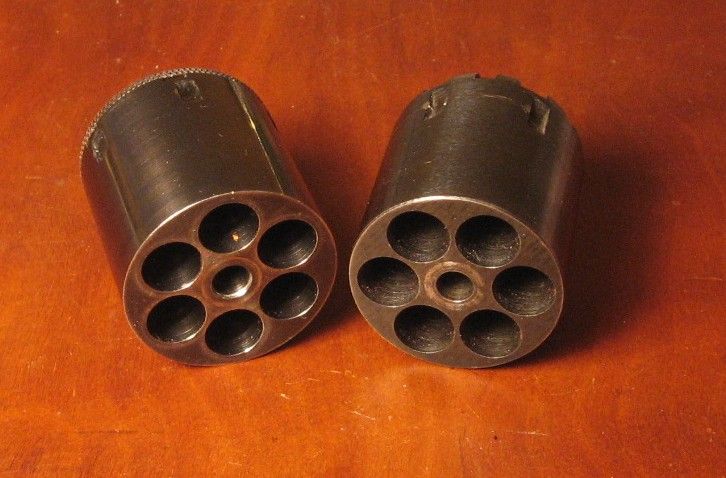
This resulted in the barrel/cylinder gap being directly in line with the front of the cylinder. Because of this, BP fouling blasted out of the gap was deposited directly onto the cylinder pin, where it worked its way onto the cylinder pin, causing the cylinder to bind with BP fouling. With the conversion cylinder the situation is the same and fouling is rapidly deposited on the cylinder pin.
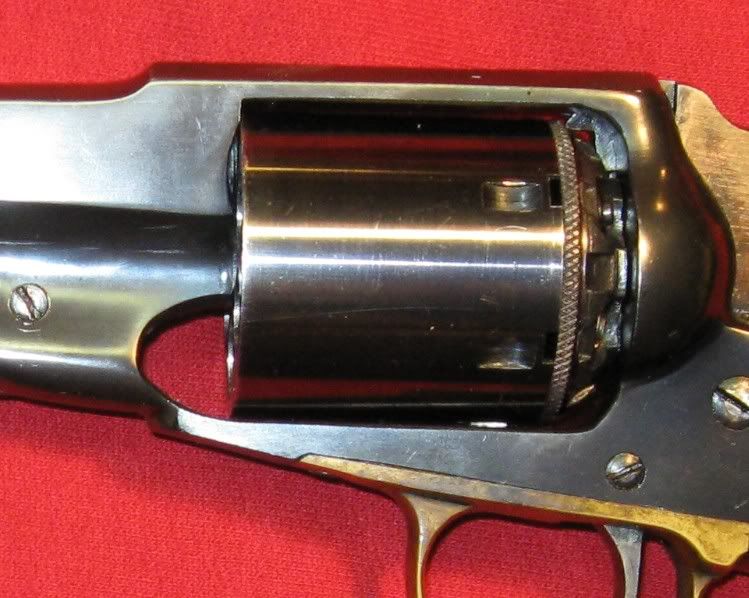
Which is another reason I prefer this design of conversion cylinder. Every time I remove the cylinder to reload, I wipe the cylinder face off with a damp rag and wipe off the cylinder pin. This allows the gun to keep shooting longer without binding up.
Incidentally, this is the same reason the modern reproductions of the Schofields do badly with Black Powder. In order to chamber the conversions for cartridges longer than the original 45 Schofield round, cartridges such as 45 Colt and 44-40, the cylinders had to be lengthened to accommodate the longer cartridges. But the frame was not stretched a proportionate amount. Instead, the gas bushing at the front of the cylinder was shortened, providing less of a shield for the arbor from BP fouling blasted out of the barrel/cylinder gap.
The original Smith and Wesson Schofield did fine with Black Powder. It had a substantial gas collar pressed into the front of the cylinder.
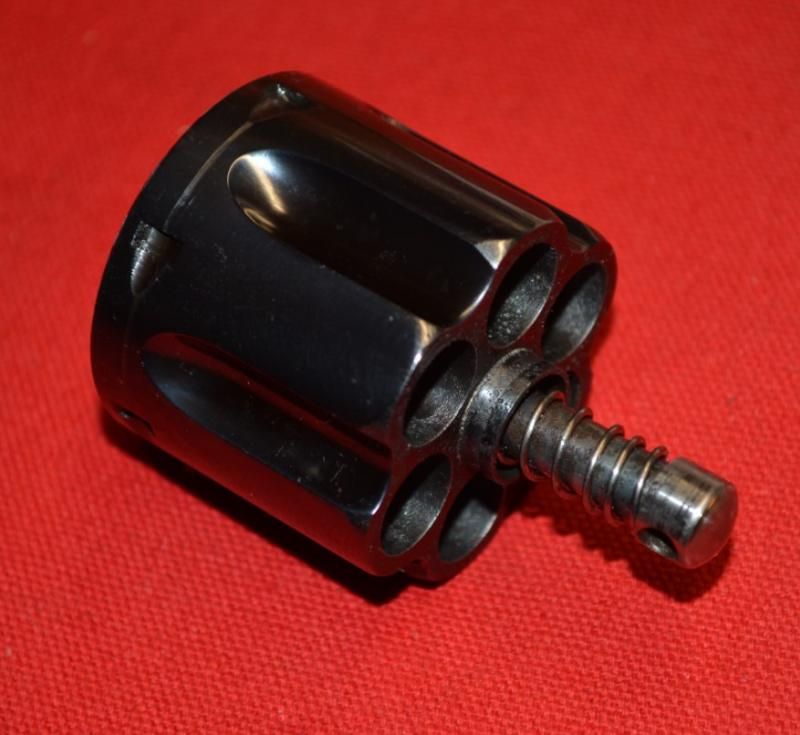
The gas collar slid over the cylinder arbor.
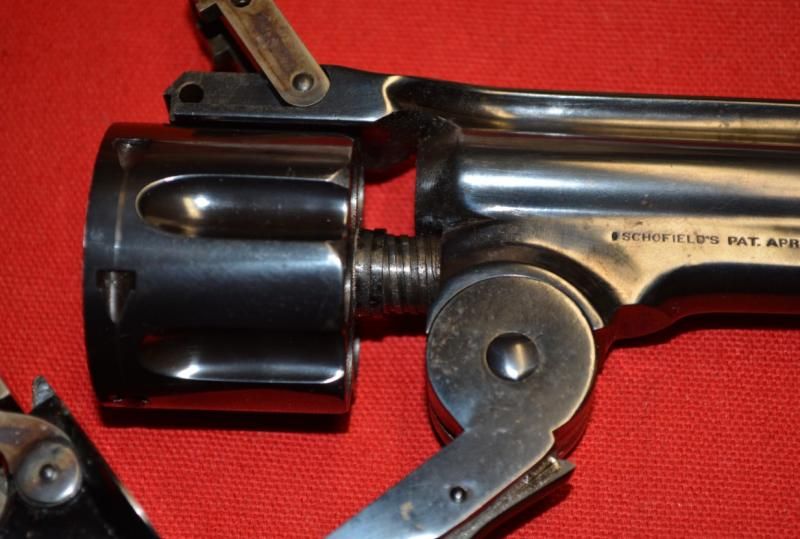
When the cylinder was pushed all the way forward, the gas bushing protected the arbor from fouling blasted out of the barrel/cylinder gap. This arrangement was the same on all the old S&W Top Break revolvers.
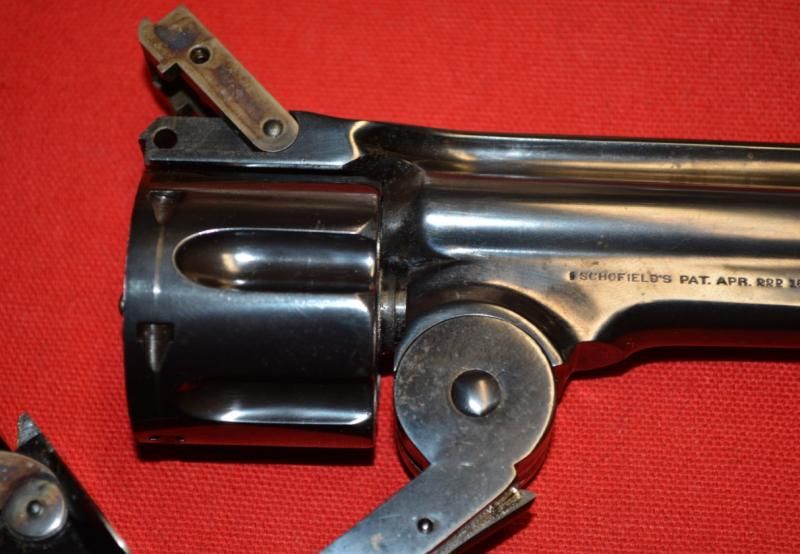
Regarding the 1875 Remington design; Remington learned their lesson and did provide a bushing on the front of the cylinder. But it is not as substantial as the bushing on the front of a Colt or colt clone. At least not with the replicas I have examined. While the 1875 design does provide protection against fouling being blasted onto the cylinder pin, nothing does as good a job to keep the cylinder rolling with modern reproductions and Black Powder as a Colt or colt clone. Rugers work very well with Black Powder too.
Granted, the economics of buying a Cap & Ball 1858 and then buying a conversion cylinder for it are not as good as buying a cartridge cylinder in the first place.
In my case, I bought this EuroArms Remmie back in 1975, and I haven't a clue what I paid for it back then. Of course conversion cylinders were not available back then. When I became aware of them around ten years ago I figured for $200 (they cost then) I would be adding a new cartridge gun to my collection for not very much money. I thought it would be great to be shooting cartridges in the old Remmie and I figured the old C&B had paid for itself a long time ago.

Then a year or two later I came across a used Uberti Stainless Remmie complete with a conversion cylinder for about the price of a used cartridge revolver. A no brainer for me.
These cylinders are the old six shot, 45 Colt cylinders that Ken Howell was producing for Taylors. It is not physically possible to fit six 45 Colt chambers in the cylinder for the 1858 Remington without the rims overlapping. So Ken had the brilliant idea of angling the chambers out ever so slightly, less than 1/2 of one degree, so six chambers could fit without the rims overlapping. And he patented the idea. At some point, Taylors bought the patent from Ken, the cylinders they are selling today are produced by somebody else. So when Ken Howell started his Old West Conversions company to produce conversion cylinders, he could not use the idea he patented because he sold the patent. That is why all of his 45 Colt cylinders for the 1858 Remington are only five shots.
This type of cylinder does require removing it every time you reload because there is no provision for a loading gate with the arrangement of the cylinder cap. Kirst makes a cylinder that has a backing piece bolted to the frame with just one firing pin. This allows one the option of carving a loading gate into the frame. However removing the cylinder is so easy on the 1858 model that it is probably quicker to reload this way than popping the empties out and reloading one chamber at a time through a loading gate.
Now, having said all that, since this is a Black Powder forum, it must be said that the 1858 Remington suffered from a design problem that made it less than perfect for shooting with Black Powder. The cylinder lacked any sort of gas bushing or collar on the front face of the cylinder.

This resulted in the barrel/cylinder gap being directly in line with the front of the cylinder. Because of this, BP fouling blasted out of the gap was deposited directly onto the cylinder pin, where it worked its way onto the cylinder pin, causing the cylinder to bind with BP fouling. With the conversion cylinder the situation is the same and fouling is rapidly deposited on the cylinder pin.

Which is another reason I prefer this design of conversion cylinder. Every time I remove the cylinder to reload, I wipe the cylinder face off with a damp rag and wipe off the cylinder pin. This allows the gun to keep shooting longer without binding up.
Incidentally, this is the same reason the modern reproductions of the Schofields do badly with Black Powder. In order to chamber the conversions for cartridges longer than the original 45 Schofield round, cartridges such as 45 Colt and 44-40, the cylinders had to be lengthened to accommodate the longer cartridges. But the frame was not stretched a proportionate amount. Instead, the gas bushing at the front of the cylinder was shortened, providing less of a shield for the arbor from BP fouling blasted out of the barrel/cylinder gap.
The original Smith and Wesson Schofield did fine with Black Powder. It had a substantial gas collar pressed into the front of the cylinder.

The gas collar slid over the cylinder arbor.

When the cylinder was pushed all the way forward, the gas bushing protected the arbor from fouling blasted out of the barrel/cylinder gap. This arrangement was the same on all the old S&W Top Break revolvers.

Regarding the 1875 Remington design; Remington learned their lesson and did provide a bushing on the front of the cylinder. But it is not as substantial as the bushing on the front of a Colt or colt clone. At least not with the replicas I have examined. While the 1875 design does provide protection against fouling being blasted onto the cylinder pin, nothing does as good a job to keep the cylinder rolling with modern reproductions and Black Powder as a Colt or colt clone. Rugers work very well with Black Powder too.
Last edited:
deerslayer303
New member
Driftwood, That was an well put together and informative post. Thank you. I too love the looks of the Remington NMA especially the 5.5" barrel version. I load 3 cylinders at a time off the gun with a press and swap em out, the cylinder pin does need a wipe down. I've noticed I have to put a liberal amount of lube on the pin before firing even one ball to make wiping the pin easier. When I first started shooting Black, I heard all the stories of how lube makes the black powder fouling softer but I never knew exactly how stubborn it can be with out lube until I didn't lube the cylinder pin on my NMA.
45 Dragoon
New member
Great post DJ!!
Deerslayer,
I'll give you my reason for conversions. Without them in my most favored guns (a pair of 1st Mod. Dragoons with Kirst gated) , I would have to drive about 40 minutes to any neighboring county, shoot black powder (which is ANOTHER reason for conversions), drive 40 mins. back home, clean the now nasty revolvers (which means allowing MORE time alotted for something I don't care for like I did for 30 yrs of my life). All that would probably translate to less time I would spend doing something I dearly love to do with revolvers that I have a tremendous amount of tuning and customizing done to them.
So, even though I choose to spend MY money on something that may not make sense to some, I get tremendous pleasure driving the 8 minutes to my local indoor range , shooting 2 or 3 boxes of .45 Colt , coming home and wiping down my treasures ( and cleaning them whenever) and then go to my shop at home and work on open tops for others that treasure their revolvers and want a custom tuned gun.
This also goes for my '60 Army (Kirst gated as well) and my Remie with six shot R&D cyl. (and part time carry).
As a side note, the guys at the range get a kick out of me bringing the "coolest" guns that get shot there!! They like taking a turn at shooting them as well!!
This is my reason for conversions and I'm sure there are as many others as there are shooters. Not to mention the historical correctness of such a set up, factory or otherwise. Thank God we live in a country where freedom is still alive (such as it is), and we can enjoy our on individual choices rather than what someone else thinks we should do. (I would refer you to your own Jefferson tag line about freedom)
Mike
www.goonsgunworks.com
P.S. $500.00 !! I wish!! More like $700.00 (everything new) not including the work done to them. The tolerances they have now are close to a Freedom Arms type arm and they are worth every penny spent (to me, which is all that matters really)!!
Deerslayer,
I'll give you my reason for conversions. Without them in my most favored guns (a pair of 1st Mod. Dragoons with Kirst gated) , I would have to drive about 40 minutes to any neighboring county, shoot black powder (which is ANOTHER reason for conversions), drive 40 mins. back home, clean the now nasty revolvers (which means allowing MORE time alotted for something I don't care for like I did for 30 yrs of my life). All that would probably translate to less time I would spend doing something I dearly love to do with revolvers that I have a tremendous amount of tuning and customizing done to them.
So, even though I choose to spend MY money on something that may not make sense to some, I get tremendous pleasure driving the 8 minutes to my local indoor range , shooting 2 or 3 boxes of .45 Colt , coming home and wiping down my treasures ( and cleaning them whenever) and then go to my shop at home and work on open tops for others that treasure their revolvers and want a custom tuned gun.
This also goes for my '60 Army (Kirst gated as well) and my Remie with six shot R&D cyl. (and part time carry).
As a side note, the guys at the range get a kick out of me bringing the "coolest" guns that get shot there!! They like taking a turn at shooting them as well!!
This is my reason for conversions and I'm sure there are as many others as there are shooters. Not to mention the historical correctness of such a set up, factory or otherwise. Thank God we live in a country where freedom is still alive (such as it is), and we can enjoy our on individual choices rather than what someone else thinks we should do. (I would refer you to your own Jefferson tag line about freedom)
Mike
www.goonsgunworks.com
P.S. $500.00 !! I wish!! More like $700.00 (everything new) not including the work done to them. The tolerances they have now are close to a Freedom Arms type arm and they are worth every penny spent (to me, which is all that matters really)!!
Last edited:
deerslayer303
New member
Of course, I don't falt anyone for going whichever way they wish with their guns or spending their hard earned cash on whatever they my choose. My statement was simply my view that's all. I don't get into a conversion. On any gun really. Cylinders, barrel liners for this and that, etc. It's just personal preference. Oh I have thought about a conversion cylinder for my Sheriff but what turned me off is the ammo limitations. I would love to own a 45 Colt that can shoot modern higher pressure ammo if I choose. On another note I totally forgot that some folks can't shoot black powder at their range. I Guess I'm just a simple country boy who thinks everyone can kick open the back door and blast away like me LOL.
45 Dragoon
New member
Ha ha! Understand. No harm no foul! I wish it was that easy to shoot here(dont we all!!)!!
Btw, I dont baby any of mine, I reload to factory spec (plus a little) and they are just fine. The '60 and the Remie bark pretty good with my loads and the Dragoons are saweet with um!!
Mike
www.goonsgunworks.com
Btw, I dont baby any of mine, I reload to factory spec (plus a little) and they are just fine. The '60 and the Remie bark pretty good with my loads and the Dragoons are saweet with um!!
Mike
www.goonsgunworks.com
